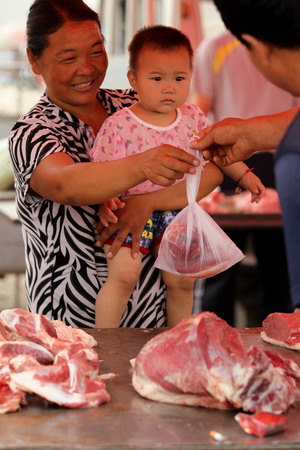Economy
Increasing pork prices breed hopes, worries
Updated: 2011-06-23 09:30
By Hu Yongqi in Shandong province and Li Jiabao in Beijing (China Daily)
Swings, stability
|
 |
|
A woman buys pork at a market in Linzi district in Zibo city, Shandong province. The average retail price of pork was 25.46 yuan a kilogram on Wednesday and likely will keep going up this year. [Photo / China Daily] |
Wang Yugui received 1,500 yuan, which eased the strain a bit, but he said it made just a small dent in his loss of 10,000 yuan.
Wang Shunlin said, "We farmers prefer a stable price for pigs as we will suffer less loss when the price undergoes a dramatic drop."
Meanwhile, pig production continues at a stable pace. A female pig, called a gilt, reaches maturity at about 8 months, but farmers usually wait two months more before letting her mate because she will produce bigger litters. Gestation takes about 114 days, four months, and once the piglets arrive, the gilt is called a sow. Piglets need six to eight months to reach market weight, Li said.
The farmer will lose money when the price of pigs for slaughter is below 14 yuan a kg, because the cost of raising a pig runs about 1,500 yuan. If the price hits 19.8 yuan a kg, the farmer can profit about 500 yuan on a 100-kg pig.
Advantages of scale
As in most businesses, the bigger producers are better able than small ones to weather price fluctuations and setbacks, such as illness. Xue, at Zibo's livestock bureau, said, "Small farm owners do not have enough money to buy sanitary facilities and they usually cure sick pigs themselves."
Usually, they must sell their market-size pigs before they can buy what they need for the smaller animals. A pen large enough for 100 pigs costs about 300,000 yuan in Wang Yugui's village, and farmers cannot afford to resume the business if they quit. If prices drop year after year, they must sell off their stock, even at a loss.
Large pig farms also are better able to recover from financial losses, so local authorities followed the central government's stipulation to support farms that raise at least 500 pigs. Now, Xue said, more than 100 farms in Zibo keep at least 1,000 pigs.
|
||||
"The price will begin to fall next June when the next pigs are supplied into the market," Li said. "It takes at least one year because many pig farmers slaughtered even their stud boars and sows when they suffered from low prices last June and diseases at the end of last year.
"Small pig farms can do well when the price is increasing," Li said, "but a single loss could drive them to bankruptcy. This is a business of high risk and high reward. Their hearts are broken after suffering from the price fluctuations in the past years."
Li's village had about 100 pig farmers 10 years ago, and now has about 20. Fewer than five of them keep more than 50 sows.
"The price of piglets was 16 yuan a kg at the end of 2010 and it is now 36 yuan, while a piglet weighs about 25 or 30 kg," Li said. "A piglet costs about 1,000 yuan now."
Add the costs of corn and vaccinations, and consider how many piglets will not make it to market. Their death rate is as high as 70 percent because of diseases, he said. "A sow bears twice a year and bears about 13 or 14 piglets when the farmer is lucky. But the farmer starts to profit when a sow bears 15 piglets."

Specials

My China story
Foreign readers are invited to share your China stories.

Pret-a-design
Though Elisabeth Koch did not attend the Aprilweddingof Prince William and Kate Middleton in London, her tailor-made hats might have.

Mom’s the word
Italian expat struggles with learning English and experiences the joys of motherhood again.



